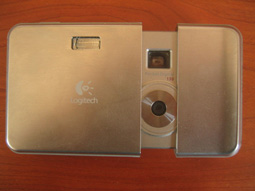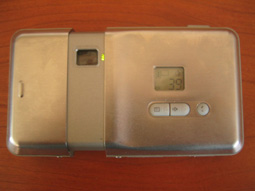Logitech Pocket Digital 130
Ever wondered how people got those perfect shots? How did Matt get that perfect picture of Bob leaking milk from his nose just as it was happening? Did he really lug around a camera to a friendly get-together, just assuming Bob would do something stupid? No, he did not. He used the Logitech Pocket Digital 130, one of the smallest cameras I have ever seen. And don't think that just because of its size it's a bad camera. On the contrary, the Pocket Digital performs very nicely. It is small enough to fit almost anywhere, and has a battery life to take you through each day. No wonder you are so intrigued…
Exterior Design
Starting with the Pocket Digital's exterior, you will notice the sleek silver case. At first glance, you many not even realize this device is a camera. There is neither a visible lens nor a flash. The front of the camera simply has a Logitech logo, an indented rectangle (the unrevealed flash), and a seemingly split portion of the case. This split portion is actually a door. A sliding door, as I would like to call it. This ‘sliding door,' is what you pull when you would like to turn the camera on and take a picture. Pulling this door reveals the flash, and the viewfinder. Now it looks more like a camera…
Logitech Pocket Digital 130: Is that a camera?
As we head over to the backside of the unit, we can just as easily say that it may not look like a camera at first glance. The only visible feature is a small screen with three buttons under it. As you pull the sliding door, a viewfinder is exposed. At the same time, the screen will light up with numbers and symbols.
At first, it may be confusing to you. You will start pressing all of the buttons below the screen randomly in order to try and get some type of response. It is not until you realize that the “take picture” button is on top of the device that you will get that puzzled look off of your face. Before I get into how the camera works, I am going to finish with the exterior.
Each side of the unit has two screws sticking out of it. If you are looking at the camera head on, you will not notice them. Once you pick up the device and hold it on the bottom and the top, you will be able to feel them. These screws are not a big deal; however, it would be better if they were concealed.
The Sliding Door Design
The sliding door I mentioned earlier plays a big part in cutting down the length of the Pocket Digital. With the sliding door closed, the camera measures about 3 1/4 inches long. With it exposed, the length becomes about 3 3/4 inches long. The sliding door reveals a half-inch of camera, which is the hidden lens and viewfinder. That means that you are saving half an inch of length by using the sliding door. What a clever idea!
How the Pocket Digital 130 Works
Now that we have covered the exterior of the unit, we'll move on to how the camera actually works. The procedure for taking a picture is very simple: turn it on, adjust any picture options if necessary, and then take a picture. Once again, turning the camera on is a piece of cake. Once you pull the sliding door out to see the lens and viewfinder, the camera is turned on. At this point, you can adjust any picture options you would like. Even though there are only three buttons, there are many options to fiddle around with. One button deals solely with flash. You can press it to turn on the flash, turn it off, or turn on the automatic flash. Another button allows you to turn off the somewhat annoying beeping noise you get every time you press a button. If you hold this button down, it will enable the self-timer. The other button changes the resolution of the picture when pressed once, and when held down can delete one or all pictures. This control system is very easy to use, and once you start using the camera, you will catch on quickly.



